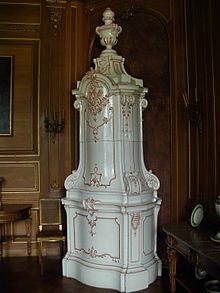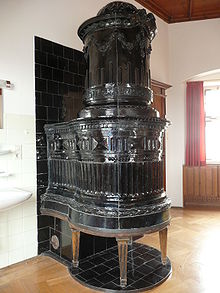- Masonry heater
-
Ceramic stoves are traditional in Northern Europe: an 18th-century faience stove at Łańcut Castle, Poland

A masonry heater (or masonry stove) is a device for warming a home (or any interior space) that captures the heat from periodic burning of fuels (primarily wood), and then radiates that heat over a long period at a fairly constant temperature. The technology exists in many forms from the Roman hypocaust to the Austrian/German kachelofen. The hypocaust is a system for heating the floors and walls of buildings (especially baths) using the smoke and exhaust of a single fire. In Eastern and Northern Europe and North Asia, these kachelofens (or steinofens) evolved in many different forms and names, such as a Russian Stove/Fireplace (Russian: Русская печь), a Finnish Stove (in Finnish: pystyuuni or kaakeliuuni, "tile oven") and the Swedish Stove (in Swedish: kakelugn, "tile stove" or "contra-flow stove") associated with Carl Johan Cronstedt. The Chinese developed the same principle into their Kang bed-stove.
Contents
Characteristics
As the name suggests, it is made of masonry, rather than steel. It is free-standing and requires a significant support structure to bear its large weight. It consists of a firebox and heat exchange channels or partitions that provide additional surface area to absorb heat from the hot exhaust gases before they exit into the chimney. Since the firebox is masonry, rather than metal, fires can and do burn much hotter than in a metal stove. These hot fires substantially reduce emissions. When not being fired, the connection from the masonry heater to the chimney is sometimes damped to help prevent heat from escaping up the chimney. The heater then radiates heat from the masonry exterior, which may be brick, tile, stone, stucco, or a combination of these materials.
Masonry takes longer to heat than metal; but once warm, the heater will also radiate this heat over a longer period of time, and at a much lower temperature than a metal stove (which is hot only when there is a fire burning inside the stove and for a short time thereafter). A masonry heater is warmed by infrequent fires that burn a short time; it is the stored heat from the fire that heats the living space. In Europe and in America, builders sometimes incorporate seats and even beds into the masonry stove because the external surfaces of a properly used heater never get hot enough to burn skin, so are very safe to touch.
Kachelofen, c.1775, Schloss Hohenaschau, Upper Bavaria
Heat stress is one major concern in the construction of masonry heaters. The differences in temperatures inside the masonry core of the heater can result in differential expansion. A skilled heater mason knows how to properly account for this stress when designing and constructing the heater, thereby preventing uneven expansion and cracks in the exterior structure.
Masonry heaters take a long time (from 5 hours up to two days) to get up to temperature, and so are not always practical for "taking the chill off" a single cool evening or morning. Rather, when put into operation, they provide dependable, even heat all day and night. They are well-suited for long periods of cold weather because they store heat so well. Because the radiant heat is at low level, a masonry heater is not likely to overheat a home the way a metal stove might in warmer parts of the year like fall or spring.
Fuel sources
These heaters are primarily fired by wood, and those fires are meant to burn hot and quick (never damped down, as is often the case with standard wood stoves). They are not burned continuously. This method of heating may have been a reaction to the dwindling resource of wood before the advent of coal and other mineral energy sources. Open hearth fireplaces were an important source of light, as well as heat, and with an "unlimited" supply of wood to fire them, there is no incentive to increase the efficiency of their heat output, which is rather poor. However, once firewood became a scarce resource, fireplace builders began to enclose the firebox to capture as much heat as possible.
Since masonry heaters burn hot and fast, they can accept any dry, split (usually three to five inches in diameter) wood. In some areas of Central and Eastern Europe, these heaters are sometimes effectively fired using grass, straw, and hay. It is also common in Eastern Europe to modify these efficient heaters so that they are connected to the gas network and are fueled with gas. Some modern models incorporate electric heating elements connected to timers. These are used only as a backup heat source during periods when the structure will be left unattended for long duration in winter (and therefore with no one to build a new fire in the heater each day or as needed) to prevent the structure from freezing.
Further reading
- Masonry Heaters: Designing, Building, and Living with a Piece of the Sun by Ken Matesz (Chelsea Green Publishing Co., 2010)
- The Book of Masonry Stoves: Rediscovering an Old Way of Warming by David Lyle (Chelsea Green Publishing Co., 1984)
See also
- Russian oven
- Rocket mass heater
External links
Categories:- Fireplaces
- Heaters
Wikimedia Foundation. 2010.


